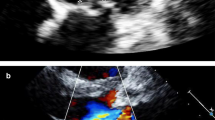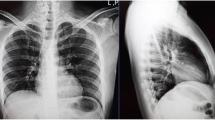Summary
We are presenting a case of endocarditis due to a penicillin-tolerantStreptococcus bovis in a 65-year-old patient. The minimal bactericidal concentration of penicillin (40 mg/l) was more than 100-fold the minimal inhibitory concentration (0.08 mg/l). The MBC of penicillin was 0.31 mg/l in the presence of 1.25 mg/l gentamicin. Cross-sectional echocardiography revealed endocarditis of the anterior leaflet of the tricuspid valve and a vegetation on the aortic valve which appeared to be pedunculated and which prolapsed into the left ventricular outflow tract during diastole. During therapy, the pedunculated part of the vegetation disappeared without signs of embolization. After initial clinical improvement, the patient died of cerebral bleeding caused by a mycotic aneurysm of the left median cerebral artery. The patient's final outcome suggested an asymptomatic embolus. Cross-sectional echocardiography was distinctly superior to M-mode echocardiography in estimating changes in the size and shape of the valve vegetation. The results of the post-mortem examination of the aortic and tricuspid valves corresponded to the echocardiographic findings.
Zusammenfassung
Bei einer 65jährigen Patientin trat eine Endokarditis durch einen Penicillin-toleranten Stamm vonStreptococcus bovis auf. Die minimale bakterizide Konzentration von Penicillin (40 mg/l) war mehr als 100fach höher als die minimale Hemmkonzentration (0,08 mg/l). In Gegenwart von 1,25 mg/l Gentamicin betrug die MBK von Penicillin 0,31 mg/l. Mittels der zweidimensionalen Echokardiographie konnten am anterioren Segel der Tricuspidalklappe endokarditische Veränderungen sowie an der Aortenklappe eine gestielte Vegetation, die während der Diastole in den linken Ventrikel prolabierte, dargestellt werden. Im Verlauf der Therapie verschwand der gestielte Anteil der Vegetation ohne Anzeichen einer Embolisation. Nach anfänglicher klinischer Besserung verstarb die Patientin schließlich an einer cerebralen Blutung, hervorgerufen durch ein mykotisches Aneurysma derArteria cerebri media sinistra. Es muß daher angenommen werden, daß das Verschwinden des gestielten Anteils der Aortenklappenvegetation einer klinisch stummen Embolie entsprach. Zum Nachweis von Veränderungen in Größe und Form der Vegetation erwies sich die zweidimensionale Echokardiographie gegenüber der eindimensionalen als deutlich überlegen. Die autoptischen Befunde an den Aorten- und Tricuspidalklappen entsprachen den echokardiographischen Befunden.
Similar content being viewed by others
Literature
Sabath, L. D., Wheeler, N., Laverdiere, M., Blazevic, D., Wilkinson, J. B. A new type of penicillin resistance ofStaphylococcus aureus. Lancet I (1977) 443–447.
Editorial: Penicillin-tolerant bacteria. Lancet I (1980) 856–857.
McDonald, M., Miles, H., Hart, D., Sonenberg, N. Penicillin tolerance inStreptococcus faecalis. Lancet II (1980) 321.
Portnoy, D., Wink, I., Richards, G. K., Blanc, M. Z. Bacterial endocarditis due to a penicillin-tolerant group C streptococcus. Can. Med. Assoc. J. 122 (1980) 69–75.
Anderson, A. W., Cruickshank, J. G. Endocarditis due to viridans-type streptococci tolerant to beta-lactam antibiotics: therapeutic problems. Br. Med. J. 285 (1982) 854.
Moellering, R. C., Watson, B. K., Kunz, L. J. Endocarditis due to group D streptococci. Comparison of disease caused byStreptococcus bovis with that produced by the enterococci. Am. J. Med. 57 (1974) 239–250.
Thornsberry, C., Baker, C. N., Facklam, R. R. Antibiotic susceptibility ofStreptococcus bovis and other group D streptococci causing endocarditis. Antimicrob. Agents Chemother. 5 (1974) 228–233.
Stafford, A., Wann, L. S., Dillon, J. C., Weyman, A. E., Feigenbaum, H. Serial echocardiographic appearance of healing bacterial vegetations. Am. J. Cardiol. 44 (1979) 754–760.
Wann, L. S., Dillon, J. C., Weyman, A. E., Feigenbaum, H. Echocardiography in bacterial endocarditis. N. Engl. J. Med. 295 (1976) 135–139.
Phair, J. P., Tan, J., Venezio, F., Westenfelder, G., Reisberg, B. Therapy of infective endocarditis due to penicillin-susceptible streptococci: Duration of disease is a major determinant of outcome. In:Bisno, A. L. (ed.): Treatment of infective endocarditis. Grune & Stratton, New York 1981, pp. 75–79.
Klein, R. S., Recco, R. A., Catalano, M. T., Edberg, S. C., Casey, J. I., Steigbigel, N. H. Association ofStreptococcus bovis with carcinoma of the colon. N. Engl. J. Med. 297 (1977) 800–802.
Author information
Authors and Affiliations
Rights and permissions
About this article
Cite this article
Mittermayer, H., Nesser, H.J. & Öhlinger, W. Endocarditis due to a penicillin-tolerant Streptococcus bovis: Microbiological findings and echocardiographic follow-up. Infection 11, 302–306 (1983). https://doi.org/10.1007/BF01641351
Received:
Accepted:
Issue Date:
DOI: https://doi.org/10.1007/BF01641351




